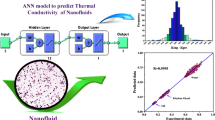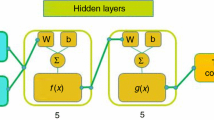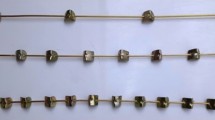Abstract
The present study aims at predicting and optimizing exergetic efficiency of TiO2-Al2O3/water nanofluid at different Reynolds numbers, volume fractions and twisted ratios using Artificial Neural Networks (ANN) and experimental data. Central Composite Design (CCD) and cascade Radial Basis Function (RBF) were used to display the significant levels of the analyzed factors on the exergetic efficiency. The size of TiO2-Al2O3/water nanocomposite was 20–70 nm. The parameters of ANN model were adapted by a training algorithm of radial basis function (RBF) with a wide range of experimental data set. Total mean square error and correlation coefficient were used to evaluate the results which the best result was obtained from double layer perceptron neural network with 30 neurons in which total Mean Square Error(MSE) and correlation coefficient (R2) were equal to 0.002 and 0.999, respectively. This indicated successful prediction of the network. Moreover, the proposed equation for predicting exergetic efficiency was extremely successful. According to the optimal curves, the optimum designing parameters of double pipe heat exchanger with inner twisted tape and nanofluid under the constrains of exergetic efficiency 0.937 are found to be Reynolds number 2500, twisted ratio 2.5 and volume fraction(v/v%) 0.05.












Similar content being viewed by others
References
Singh PK, Anoop KB, Sundararajan T, Das S (2010) Entropy generation due to flow and heat transfer in nanofluids. Int J Heat Mass Transf 53:4757–4767
Karami M, Shirani E, Avara A (2012) Analysis of entropy generation, pumping power, and tube wall temperature in aqueous suspensions of alumina particles. Heat Transfer Res 43(4):327–342
Oztop FH, Abu-Nada E (2008) Numerical study of natural convection in partially heated rectangular enclosures filled with nanofluids. Int J Heat Fluid 29:1326–1336
Bhuva BV, Soni S (2015) Experimental investigation of Exergy & energy analysis of double pipe heat exchanger using twisted tape. Int J Sci Res Dev| 3(4):2321–0613
Maddah H, Ghasemi N (2017) Experimental evaluation of heat transfer efficiency of nanofluid in a double pipe heat exchanger and prediction of experimental results using artificial neural networks. Heat Mass Transf:1–14. https://doi.org/10.1007/s00231-017-2068-6
Aghayari R, Maddah H, Baghbani Arani B, Mohammadiun H, Nikpanje H (2015) An experimental investigation of heat transfer of Fe2O3/water nanofluid in a double pipe heat exchanger. Int J Nano Dimensions 6(5):517–524
Hosseinian Naeini A, Baghbani Arani J, Narooei A, Aghayari R, Maddah H (2016) Nanofluid thermal conductivity prediction model based on artificial neural network. Trans Phenom Nano Micro Scales 4(2):41–46
Naphon P (2011) Study on the Exergy loss of the horizontal concentric micro-fin tube heat exchangers. Int Commun Heat Mass Transfer 38:229–235
Yilmaz M, Sara ON, Karsli S (2001) Performance evaluation criteria for heat exchangers based on second law analysis. Exergy Int J 1(4):278–294
Naphon P (2006) Second law analysis of the heat transfer of the horizontal concentric tube heat exchanger. Int Commun Heat Mass Transfer 1029–1041
Ningbo Z, Li S, Zhitao W, Yunpeng C (2014) Prediction of viscosity of nanofluids using artificial neural networks. Heat Transfer and Thermal Engineering. https://doi.org/10.1115/IMECE2014-40354
Li P, Xie Y, Zhang D, Xie G (2016) Heat transfer enhancement and entropy generation of nanofluids laminar convection in microchannels with flow control devices. Entropy 18(134):1–15
Yu J, Zhang H-C, Xie Y, Shi L (2017) Entropy generation analysis and performance evaluation of turbulent forced convective heat transfer to nanofluids. Entropy 19(108):1–18
Myers R (1976) Response Surface Methodology. Edwards Brothers, Ann Arbor, MI
Haykin S (1999) Neural networks: a comprehensive foundation, 2nd edn. Prentice Hall PTR, Upper Saddle River
Xu P, Xu S, Yin H (2007) Application of delf-organization competitive neural network in fault diagnosis of suck rod pumping system. J Pet Sci Eng 58:43
Vaferi B, Rahnam Y, Darvishi P, Toorani AR, Lashkarbolook M (2013) Phase equilibrium estimation of binary systems containing ethanol using optimal feed forward neural network. J Supercrit Fluids 84:80
Sreekanth S, Ramasamy HS, Sablani SS, Prasher SO (1999) A neural network approach for evaluation of surface heat transfer coefficient. J Food Process Preserv 23:329–348
Parcheco VA, Sen M, Yang KT, Meclain RL (2001) Neural network analysis of fin-tube refrigerating heat exchanger with limited experimental data. Int J Heat Mass Transf 44(4):763–770
Haykin S (1994) Neural networks, a comprehensive foundation, 1st edn. Prentice Hall PTR, Upper Saddle River
Aydinalp M, Ugursal VI, Fung AS (2001) Predicting residential appliance, lighting, and space cooling energy consumption using neural networks. Proceeding of ITEC2001, International Thermal Energy Congress Cesme Turkey 417
Hartman E, Keeler JD, Kowalski JM (1990) Layered neural networks with Gaussian hidden units as universal approximations. Neural Comput 2(2):210–215
Montazer GA, Khoshniat H, Fathi V (2013) Improvement of RBF neural networks using Fuzzy-OSD algorithm in an online radar pulse classification system. Appl Soft Comput 13(9):3831–3838
Iliyas SA, Elshafei M, Habib MA, Adeniran AA (2013) RBF neural network inferential sensor for process emission monitoring. Control Eng Pract 21(7):962–970
Chen S, Cowan CFN, Grant PM (1991) Orthogonal least squares learning algorithm for radial basis function networks. IEEE Trans Neural Netw 2(2):302–309
Mmohammadiun M, Dashtestani F, Alizadeh M (2016) Exergy prediction model of a double pipe heat exchanger using metal oxide nanofluids and twisted tape based on the artificial neural network approach and experimental results. J Heat Transf 138:1–10
Box GEP, Draper NR (1975) Robust Designs. Biometrika 62:347–352
Hunter WG, Hunter JS (1978) Statistics for experimenters: an introduction to design, data analysis, and model building. Wiley, New York, NY
Author information
Authors and Affiliations
Corresponding author
Rights and permissions
About this article
Cite this article
Ghasemi, N., Aghayari, R. & Maddah, H. Designing an artificial neural network using radial basis function to model exergetic efficiency of nanofluids in mini double pipe heat exchanger. Heat Mass Transfer 54, 1707–1719 (2018). https://doi.org/10.1007/s00231-017-2261-7
Received:
Accepted:
Published:
Issue Date:
DOI: https://doi.org/10.1007/s00231-017-2261-7




